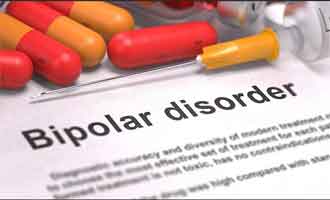- Home
- Editorial
- News
- Practice Guidelines
- Anesthesiology Guidelines
- Cancer Guidelines
- Cardiac Sciences Guidelines
- Critical Care Guidelines
- Dentistry Guidelines
- Dermatology Guidelines
- Diabetes and Endo Guidelines
- Diagnostics Guidelines
- ENT Guidelines
- Featured Practice Guidelines
- Gastroenterology Guidelines
- Geriatrics Guidelines
- Medicine Guidelines
- Nephrology Guidelines
- Neurosciences Guidelines
- Obs and Gynae Guidelines
- Ophthalmology Guidelines
- Orthopaedics Guidelines
- Paediatrics Guidelines
- Psychiatry Guidelines
- Pulmonology Guidelines
- Radiology Guidelines
- Surgery Guidelines
- Urology Guidelines
Can early symptoms predict bipolar disorder? Evidence shows differing patterns of risk factors

Two patterns of antecedent or "prodromal" psychiatric symptoms may help to identify young persons at increased risk of developing bipolar disorder (BD), according to a new analysis in the Harvard Review of Psychiatry. The journal is published by Wolters Kluwer.
Early signs of BD can fall into a relatively characteristic "homotypic" pattern, consisting mainly of symptoms or other features associated with mood disorders; or a "heterotypic" pattern of other symptoms including anxiety and disruptive behavior. Environmental risk factors and exposures can also contribute to BD risk, according to the analysis by Ciro Marangoni, MD, at the Department of Mental Health, Mater Salutis Hospital, Legnato, Italy; Gianni L. Faedda, MD, Director of the Mood Disorder Center of New York, NY, and Co-Chairman of a Task Force of the International Society for Bipolar Disorders on this topic; and Professor Ross J. Baldessarini, MD, Director of the International Consortium for Bipolar & Psychotic Disorders Research of the Mailman Research Center at McLean Hospital in Belmont, Mass.
Different Symptom Patterns, Differing Implications for BD Risk
The authors reviewed and analyzed data from 39 studies of prodromal symptoms and risk factors for later development of BD. Their analysis focused on high-quality evidence from prospective studies in which data on early symptoms and risk factors were gathered before BD was diagnosed.
BD is commonly preceded by early depression or other symptoms of mental illness, sometimes years before BD develops, as indicated by the onset of mania or hypomania. Nevertheless, the authors note that "the prodromal phase of BD remains incompletely characterized, limiting early detection of BD and delaying interventions that might limit future morbidity."
The evidence reviewed suggested two patterns of early symptoms that "precede and predict" later BD. A homotypic pattern consisted of affective or mood-associated symptoms that are related to but fall short of, standard diagnostic criteria for BD: for example, mood swings, relatively mild symptoms of excitement, or major depression, sometimes severe and with psychotic symptoms.
The authors note that homotypic symptoms have "low sensitivity"--that is, most young people with these mood symptoms do not later develop BD. However, this symptom pattern also had "moderate to high specificity"--homotypic symptoms do occur in many patients who go on to develop BD.
The heterotypic pattern consisted of other types of prodromal symptoms, such as early anxiety and disorders of attention or behavior. This pattern had low sensitivity and specificity: relatively few patients with such symptoms develop BD, while many young people without heterotopic symptoms do develop BD.
The study findings also associate several other factors with an increased risk of developing BD, including preterm birth, head injury, drug exposures (especially cocaine), physical or sexual abuse, and other forms of stress. However, for most of these risk factors, both sensitivity and specificity are low.
Although many elements of the reported patterns of prodromal symptoms and risk factors have been identified previously, the study increases confidence that they are related to the later occurrence of BD. The researchers note that the findings of high-quality data from prospective studies are "encouragingly similar" to those of previous retrospective and family-risk studies.
"There was evidence of a wide range of [psychiatric] symptoms, behavioral changes, and exposures with statistically significant associations with later diagnoses of BD," the authors conclude. With further study, the patterns of prodromal symptoms and risk factors may lead to new approaches to identifying young persons who are likely to develop BD, and might benefit from early treatment. The investigators add that predictive value might be even higher with combinations of multiple risk factors, rather than single predictors.

Disclaimer: This site is primarily intended for healthcare professionals. Any content/information on this website does not replace the advice of medical and/or health professionals and should not be construed as medical/diagnostic advice/endorsement or prescription. Use of this site is subject to our terms of use, privacy policy, advertisement policy. © 2020 Minerva Medical Treatment Pvt Ltd